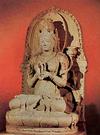- Prajnaparamita
-
The main texts, written 100 BCE–150 CE, represent prajna (wisdom) as the supreme perfection and the primary avenue to nirvana. The content of this wisdom is the realization that all phenomena are illusory. The name Prajnaparamita also refers to the personification of the literature or of wisdom, often depicted as a woman with her hands in the teaching gesture or holding a lotus and sacred book.
 Prajnaparamita, 13th-century stone sculpture from Singosari, East Java; in the Museum Pusat, ...By courtesy of the Rijksmuseum voor Volkenkunde, Leiden, Neth.
Prajnaparamita, 13th-century stone sculpture from Singosari, East Java; in the Museum Pusat, ...By courtesy of the Rijksmuseum voor Volkenkunde, Leiden, Neth.* * *
▪ Buddhist literature(Sanskrit: “Perfection of Wisdom”), body of sutras and their commentaries that represents the oldest of the major forms of Mahāyāna Buddhism, one that radically extended the basic concept of ontological voidness (sunyata); the name also denotes the female personification of the literature or of wisdom, sometimes called the Mother of All Buddhas. In the Prajñāpāramitā texts, prajna (wisdom), an aspect of the original eightfold path, has become the supreme paramita (perfection) and the primary avenue to Nirvāṇa. The content of this wisdom is the realization of the illusory nature of all phenomena—not only of this world, as in earlier Buddhism, but of transcendental realms as well.The main creative period of Prajñāpāramitā thought extended from perhaps 100 BC to AD 150. The best-known work from this period is the Aṣṭasāhasrikā (“8,000-Verse”) Prajñā-pāramitā. The first Chinese translation appeared in AD 179. Later, some 18 “portable editions” were forthcoming, the best known of which is the Diamond Sūtra (q.v.). Still later, schematic and scholastic commentaries were produced in the Mādhyamika (“Middle Way”) monasteries of eastern India, thus introducing into the Prajñāpāramitā movement the same confining rationalism against which it had reacted in the first place. The radically antiontological stance had been intended to free the spirit in its quest for experiential enlightenment.The way of negation, however, is not the sole content of these texts. They incorporate, as aids to meditation, the numerical lists (mātṛkā) also found in Abhidharma (scholastic) literature. They also supplement their philosophical austerity with the personally appealing figures of mythology.The Chinese traveler Fa-hsien described images of the personified Prajñāpāramitā in India as early as AD 400, but all known existent images date from 800 or later. She is usually represented yellow or white in colour, with one head and two arms (sometimes more), the hands in the teaching gesture (dharmacakra-mudrā) or holding a lotus and the sacred book. Also frequently associated with her are a rosary, sword (to cleave away ignorance), thunderbolt (vajra, symbolizing the emptiness of the void), or begging bowl (renunciation of material goods being a prerequisite to the obtaining of wisdom). Images of the deity are found throughout Southeast Asia and in Nepal and Tibet. In Tantric Buddhism she is described as the female consort of the Ādi-Buddha (first Buddha).* * *
Universalium. 2010.
